

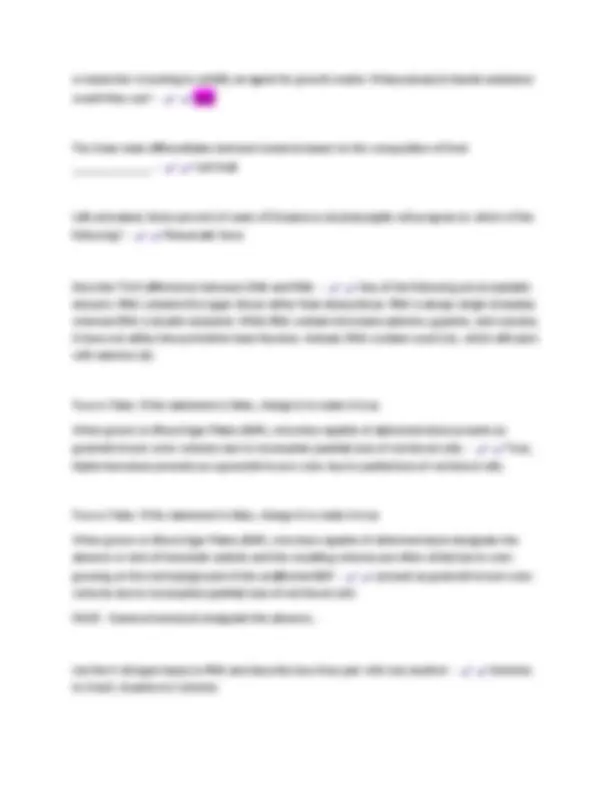
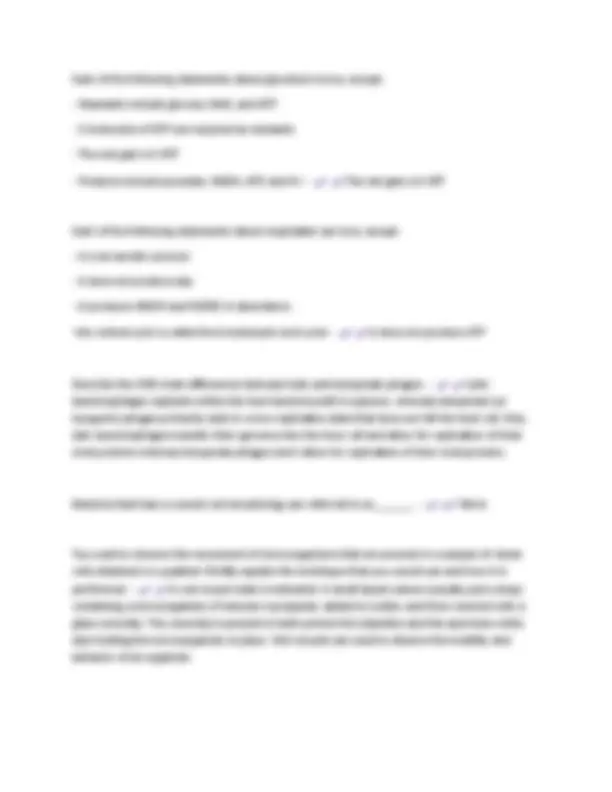
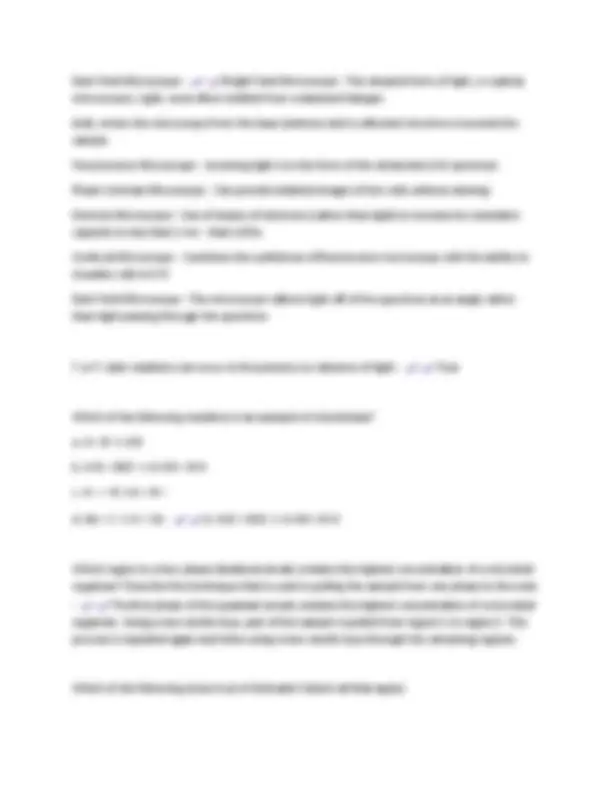
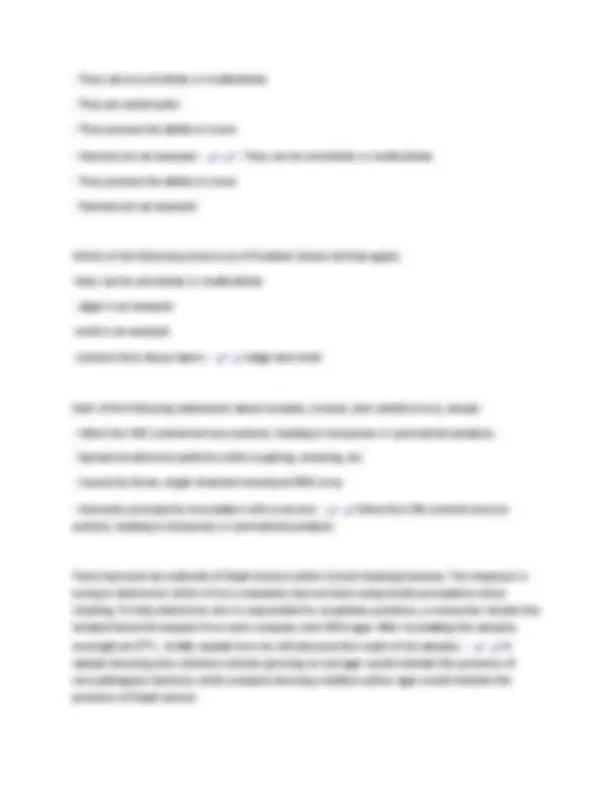
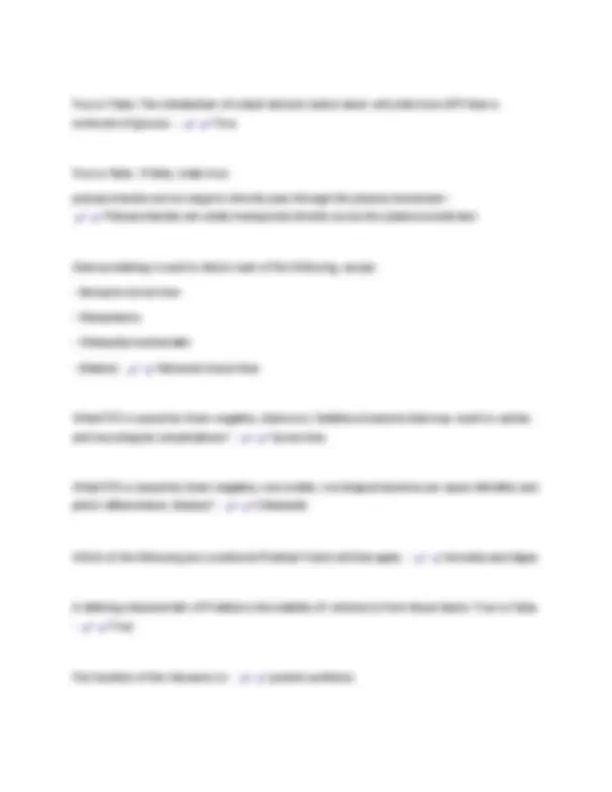
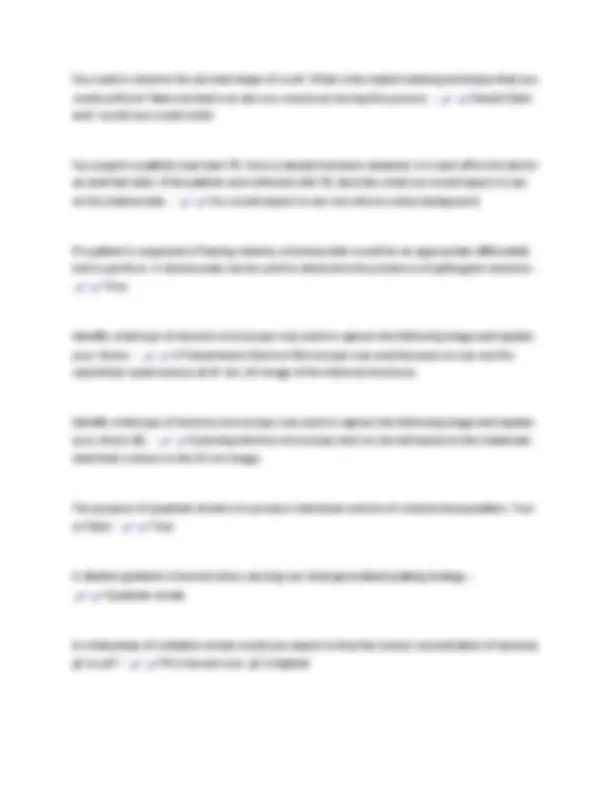

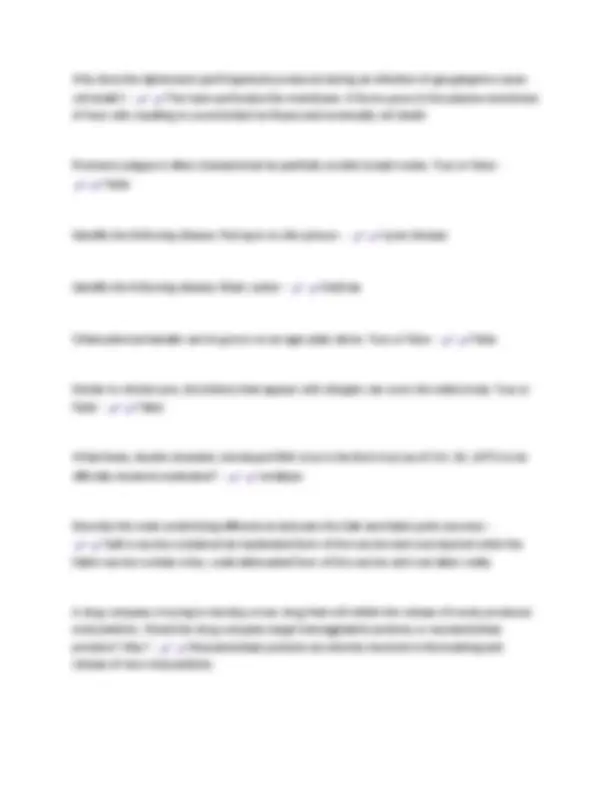


Study with the several resources on Docsity

Earn points by helping other students or get them with a premium plan


Prepare for your exams
Study with the several resources on Docsity

Earn points to download
Earn points by helping other students or get them with a premium plan
Community
Ask the community for help and clear up your study doubts
Discover the best universities in your country according to Docsity users
Free resources
Download our free guides on studying techniques, anxiety management strategies, and thesis advice from Docsity tutors
Match each of the following organelles with the correct description. Nucleus Endoplasmic Reticulum Lysosomes Chloroplasts - Nucleus - Contains genomic content of the cell Endoplasmic Reticulum - Series of membrane-enclosed sacs and interconnected tubes Lysosomes - Contain hydrolytic enzymes capable of degrading unwanted cellular debris Chloroplasts - Site of photosynthesis A virus is considered a microorganism. True or False - False What is the smallest biological unit of life? - A cell What are the four main types of macromolecules? - carbohydrates proteins, nucleic acids, lipids, proteins are formed from various combinations of ________________ - Briefly explain how a Scanning Electron Microscope (SEM) forms an image of subcellular organelles, substrates, and viral particles. - the interactions of electrons as they reflect off (not through) the surface of the specimen. amino acids
Typology: Exams
1 / 16

This page cannot be seen from the preview
Don't miss anything!










Match each of the following organelles with the correct description. Nucleus Endoplasmic Reticulum Lysosomes Chloroplasts - Nucleus - Contains genomic content of the cell Endoplasmic Reticulum - Series of membrane-enclosed sacs and interconnected tubes Lysosomes - Contain hydrolytic enzymes capable of degrading unwanted cellular debris Chloroplasts - Site of photosynthesis A virus is considered a microorganism. True or False - False What is the smallest biological unit of life? - A cell What are the four main types of macromolecules? - proteins, nucleic acids, lipids, carbohydrates proteins are formed from various combinations of ________________ - amino acids Briefly explain how a Scanning Electron Microscope (SEM) forms an image of subcellular organelles, substrates, and viral particles. - An image is formed from the interactions of electrons as they reflect off (not through) the surface of the specimen.
Samples are coated in either gold or palladium to enhance electron reflections. The reflection is seen in 3-D rendering. How many amino acids are essential? - 20 Match each of the following diseases to the correct bacterial family. Scalded Skin Syndrome Bubonic PLague Opthalmia Neonatorium Legionnaires - Scalded Skin Syndrome - Staph Aureus Bubonic Plague - Yersina Pestis Opthalmia Neonatorium - Staphylococcus Legionnaires - Legionella Identify each of the following microorganisms as either a Prokaryote or a Eukaryote. E.coli Archaeons Yeast Amoeba - E.coli - Prokaryote Archaeons - Prokaryote Yeast - Eukaryote Amoeba - Eukaryote Match each of the following terms with the correct description. Phototroph
a researcher is looking to solidify an agent for growth media. What polysacc2charide substance would they use? - agar The Gram stain differentiates between bacteria based on the composition of their _____________. - Cell Wall Left untreated, three percent of cases of Streptococcal pharyngitis will progress to which of the following? - Rheumatic fever Describe TWO differences between DNA and RNA. - Any of the following are acceptable answers: RNA contains the sugar ribose rather than deoxyribose. RNA is always single-stranded, whereas DNA is double-stranded. While RNA contains the bases adenine, guanine, and cytosine, it does not utilize the pyrimidine base thymine. Instead, RNA contains uracil (U), which still pairs with adenine (A). True or False. If the statement is false, change it to make it true. When grown on Blood Agar Plates (BAP), microbes capable of alpha hemolysis present as greenish-brown color colonies due to incomplete (partial) lysis of red blood cells. - True; Alpha hemolysis presents as a greenish-brown color due to partial lysis of red blood cells. True or False. If the statement is false, change it to make it true. When grown on Blood Agar Plates (BAP), microbes capable of delta hemolysis designate the absence or lack of hemolytic activity and the resulting colonies are often white/tan in color growing on the red background of the unaffected BAP - present as greenish-brown color colonies due to incomplete (partial) lysis of red blood cells FALSE - Gamma-hemolysis designate the absence... List the 4 nitrogen bases in RNA and describe how they pair with one another - Adenine to Uracil, Guanine to Cytosine
Each of the following statements about glycolysis is true, except:
True or False: Proteins can function to catalyze biochemical processes and play a role in structure, but they cannot enable movement. - False. Proteins can function to catalyze biochemical processes, play a role in structure, and they can enable movement. True or false: if false, make it true Lipids are primarily composed of __________ hydrocarbons FALSE: Lipids are primarily composed of ___________ hydrocarbons - Lipids are primarily composed of hydrophilic hydrocarbons FALSE: Lipids are primarily composed of hydrophobic hydrocarbons Would one of the SARS-coV-2 vaccines give immunity against SARS or MERS infection? Explain - SARS: the vaccine only has biological material for the specific spike protein which would be SARS, hence the name of the vaccine. There are unique vaccines to different strands on infections You are working with a patient who claims a friend "got the COVID-19 infection from the vaccine". Explain why the viral vector vaccine used to prevent the COVID-19 infection cannot transmit the actual infection. - The genome in the viral vector only encodes for a spike protein and not the other components of the virus. Therefore, new virions or virus particles cannot be made or replicated. Match each type of microscopy with the correct description. Bright Field Microscope Fluorescence Microscope Phase Contrast Microscope Electron Microscope Confocal Microscope
Dark Field Microscope - Bright Field Microscope - The simplest form of light, or optical, microscopes. Light, most often emitted from a standard halogen bulb, enters the microscope from the base (bottom) and is reflected via mirrors towards the sample. Fluorescence Microscope - Incoming light is in the form of the ultraviolet (UV) spectrum Phase Contrast Microscope - Can provide detailed images of live cells without staining Electron Microscope - Use of beams of electrons (rather than light) to increase its resolution capacity to less than 1 nm - that's 200x. Confocal Microscope - Combines the usefulness of fluorescence microscopy with the ability to visualize cells in 3-D Dark Field Microscope - The microscope reflects light off of the specimen at an angle rather than light passing through the specimen T or F: dark reactions can occur in the presence or absence of light - True Which of the following reactions is an example of a hydrolase? a. A + B → A-B b. A-B + H2O → A-OH + B-H c. A— + B →A + B— d. Ab + C → A + Cb - b. A-B + H2O → A-OH + B-H Which region in a four phase dilutional streak contains the highest concentration of a microbial organism? Describe the technique that is used in pulling the sample from one phase to the next.
True or False: The metabolism of a lipid-derived carbon atom will yield more ATP than a molecule of glucose. - True True or false : if false, make true polysaccharides are too large to directly pass through the plasma membrane - Polysaccharides are easily transported directly across the plasma membrane Giemsa staining is used to detect each of the following, except:
True or False: The distinguishing characteristic of Gram-Negative bacteria is the presence of LPS in the outer membrane - True Identify the following cellular components by matching the number with the description. -
You want to observe the size and shape of a cell. What is the easiest staining technique that you could perform? Name at least one dye you would use during this process. - Simple Stain and I would use crystal violet You suspect a patient may have TB. Once a sample has been obtained, it is sent off to the lab for an acid-fast stain. If the patient were infected with TB, describe what you would expect to see on the stained side. - You would expect to see red cells on a blue background. If a patient is suspected of having malaria, a Giemsa stain would be an appropriate differential test to perform. A Giemsa stain can be used to determine the presence of pathogenic bacteria. - True Identify what type of electron microscope was used to capture the following image and explain your choice. - A Transmission Electron Microscope was used because we can see the subcellular substructures at 20 nm, 2D image of the internal structures. Identify what type of electron microscope was used to capture the following image and explain your choice (B). - Scanning electron microscope and we can tell based on the trademark shell that is shown in the 20 nm image. The purpose of quadrant streak is to produce individual colonies of a bacterial population. True or False - True A dilution gradient is formed when carrying out what generalized plating strategy. - Quadrant streak. In what phase of a dilution streak would you expect to find the lowest concentration of bacteria, p2 or p4? - P4 is lowest conc. p2 is highest
True or False. Chlyamida is an obligate parasite and as such can be grown on agar plates alone. - False When performing a dilution streak a new loop must be used for each phase. - True, a new loop IS required In order to encourage growth of a slow growing microbe what might a researcher do during a phase dilution streak> - A research may either opt to perform a 3 phase dilution streak or pass the loop through the previous phase multiple times. A loop can pass through a previous phase multiple times if: - The gradient has the growth of individual colonies. To restrict the growth of a pathogenic microbe a researcher might decrease an incubator from 37ºC to 25ºC. - True When given an unknowin bacterial sample the first step is to expand the current bacterial population. Which form of media supports this need and why? - LB media is the best because all other options are selective media and might potentially inhibit the growth of the unknown sample. Directly ingesting clostridrum or its associated pores will not cause illness in adults. True or False
A drug company is trying to develop a new drug that will inhibit viral entry of Influenza. Would the drug company target hemagglutinin proteins or neuraminidase proteins? Why? - Hemagglutinins because hemagglutinins are involved in entry of viral particle into a host's cell. The viral capsid of HIV is dumbbell shaped and contains 2000 copies of p24. True or False - False what small (30nm) single stranded non enveloped RNA virus causes temporary or permanent paralysis by infiltrating motor neurons with in the spinal cord brainstem or motor cortex - polio.